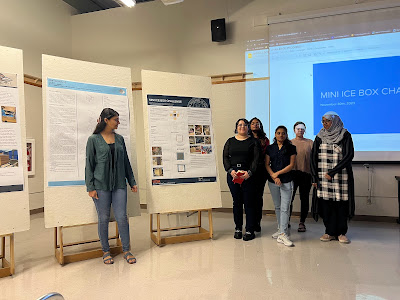Yesterday I had the opportunity to watch three groups of graduate architecture students present and unveil the results of their Mini Ice Box Challenge at UTSA here in San Antonio, Texas.
The goal was to design and build a structure that would minimize the melting of ice stored within while set outside for several days.
The presentations were thoughtful, and the results suspenseful:)
Below is a flier created to promote the challenge, an activity intended to be further developed and part of an ongoing effort to foster innovative thinking in architecture.
I was invited, along with several others, to hear the final presentation, ask questions, and comment.
Reviewers
- Erik Murray, Building Enclosure Architect, Wiss Janney Elstner Associates
- Stephen Brady Dietert, Dietert Design Studio
- Roy Schauffele, Division 7 Solutions, Inc.
- Keith Simon, Building Enclosures Practice Lead at Terracon
- Dan Stine, Lake|Flato
Several UTSA faculty also attended and offered insightful feedback.
Professor
- Dr. Maryum Singery, UTSA School of Architecture
The class is ARC 5713-Environmental Architecture and Sustainability.
The structures were placed outside on metal framed tables (see photo above) and had specific limitations, such as overall size.
As reviewers, we were asked to guess which project would have the most unmelted ice remaining... I am happy to report I guessed correctly:) I will highlight each team in the order of most ice remaining, starting with the winning team.
Click to enlarge images.
Team 2
While this project had some thermal bridging, it had the highest r-value on all sides. The shape and orientation likely also helped.
Team 3
This team did a great job thinking outside the box and used computational design and 3d printing to create something akin to a Yeti cooler. However, the trade-off of a cooler needing to be portable (lighter) resulted in a lower r-value. But, the concept may have an application in the broader industry (I encouraged them to pursue that). In any case, this is a great example of how academia can help test the viability of future products!
Team 1
This was a great project but it had one issue that was not accounted for. The base was a small concrete slab, and the thought was that thermal mass would be a benefit. But the structure was placed on a table, not set on the ground as the group thought it would be. Still, several of us reviewers spoke about the value of insulating a slab to prevent thermal bridging in this situation. All the comments were positive and revived with enthusiasm:)
A quick selfie with Professor Singery and a quote:)
"The goal is to encourage a positive and collaborative environment where students can explore innovative ideas focusing on decarbonization, embrace sustainability, and enjoy the learning process by experience."
In the end, while this was technically a competition, the students were all eager to hear our feedback and were incredibly supportive of each other. This is wonderful, considering we all must work together (academics and professionals alike) to move the needle on climate change and other serious challenges facing our industry and society.
Congratulations to all the students involved, Dr. Singery, and UTSA for engaging in great activities like this.
For BIM Chapters updates, follow @DanStine_MN on Twitter or connect on LinkedIn
Lighting design professionals: check out my Revit & ElumTools training https://bit.ly/3NJjhCV

















